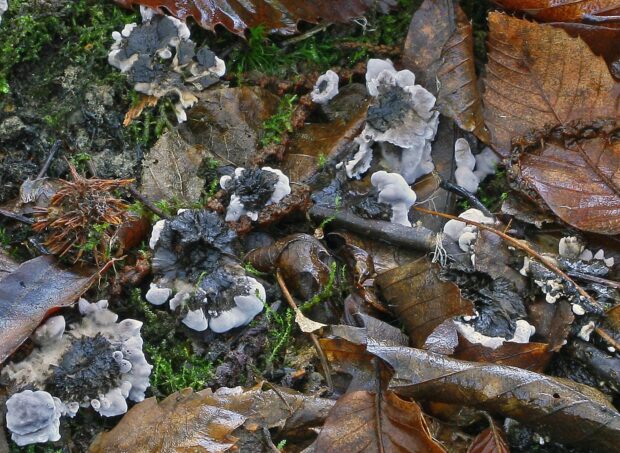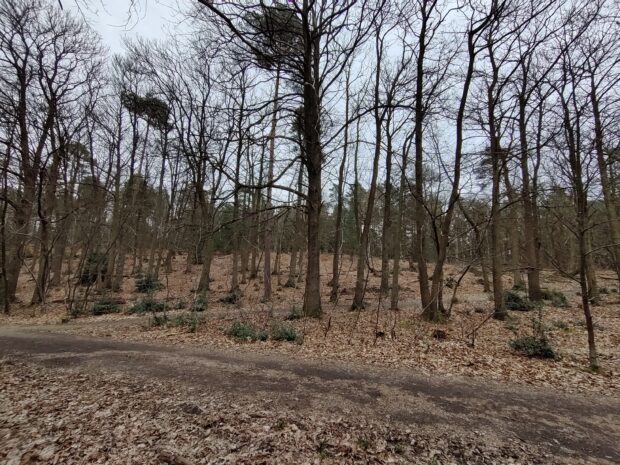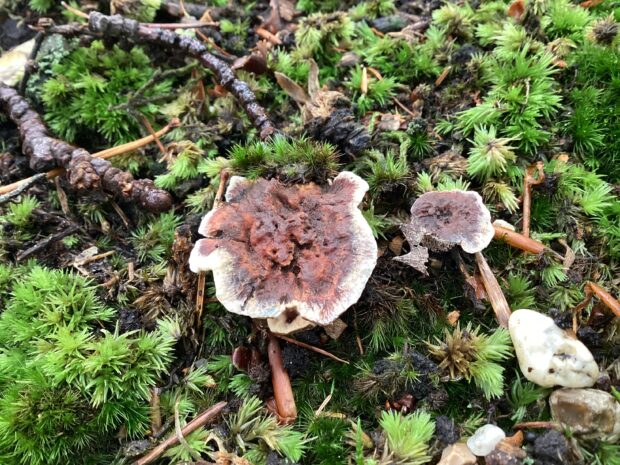In celebration of UK Fungus Day, Matt Wainhouse, Fungi Senior Specialist at Natural England shares some of our work on the conservation of tooth-fungi and some remarkable discoveries.

Few great discoveries begin with a detour off the M4 in wet weather, but last October, that’s exactly where I found myself. I was in search of the illusive Taiga-tooth fungus, which had evaded capture for so long. This search was the culmination of 18 months of investigation into the conservation of tooth-fungi. My hopes had not been high, but what I found was certainly surprising to say the least…
Fantastic Fungi
Fungi are a mega-diverse kingdom and fundamental to the ecological processes that underpin entire ecosystems. They provide plants with nutrients and protect against drought and disease. They are decomposers of complex plant material, recycling carbon and other nutrients and making soils. They are a food source for animals and, of course, agents of population control in plants and animals. With so many roles, it’s hard not to get excited about them. There are more than 18,000 species of fungi in the UK, most of which have never been studied, which means that we have so many more surprises awaiting us!
Conservation with teeth
The tooth fungi (or hydnoids, meaning hedgehog-like) are a rare and remarkable group with spines where other mushrooms might have gills. They are a small, but relatively well studied group, yet they still have the capacity to surprise us.
The heathy chestnut-pine woods on the gravel sands of Swinley Forest, East Berkshire, have been a hot-spot for tooth fungi since they were first recorded there in the 1800s. Royal Botanic Gardens, Kew mycologist Dr. Martyn Ainsworth had studied the Swinley Forest hydnoid hotspots for 20 years. However, as there had been no monitoring of these important sites for the last 15 years, their current status was unclear.

Just like plants and animals, fungi face many of the same pressures on their populations. The hydnoid fungi are found in environments with very low soil nitrogen. The symbiotic relationship these fungi have with trees is disrupted by nitrogen deposition from agriculture and fossil fuel burning. In the densely populated commuter belt, this majorly threatens their survival. Their highly specific habitat requirements also make them vulnerable to forestry where a population could be accidentally destroyed by a tractor.
Therefore, a collaborative project between Natural England, Kew, University of Aberystwyth and Crown Estate was established to perform a health check on these fungi. In October 2022, we set out to Swinley Forest, unsure of what, if anything, we might find.
DNA detectives
The randomness of fungal fruiting patterns makes population monitoring a challenge, requiring as much fortune as skill. Thankfully, we can use environmental DNA (eDNA) to identify all species found in water, soil, wood and even air by reading their DNA like barcodes.
We collected soil samples and sent them to Prof. Gareth Griffth at University of Aberystwyth, who is a global expert in fungal eDNA. Five species had been recorded by Martyn Ainsworth, including a small tooth fungus that he didn’t recognise and assumed to be an odd, immature fruitbody that hadn’t yet developed those characteristics needed for identification. Specimens were photographed, collected, dried and sent to Kew for further DNA analysis as part of the “Darwin Tree of Life” project.
This Is Exciting!
Once returned, the eDNA results were remarkable. When they were forwarded onto Martyn, he replied simply with “This is Exciting!”. It was great news and meant that the Swinley Forest hydnoids were in better health than we had expected. All of the species that had been previously recorded were found, including The Crowned-tooth, Hydnellum lepidum, which, until recently, was thought to be extinct in the UK. Another species, Hydnellum nemorosum was detected in soil at its only known location in the UK. Despite only being described in 2021, this species may already be globally endangered.
However, it was the most abundant species in the DNA results that was the greatest surprise to us – the Taiga-tooth, Phellodon secretus – a ‘new-to-Britain’ species and one only described 20 years ago from boreal taiga forests. A second look by Kew mycologists Alexandra Dombrowski and Dr. Roseina Woods found that the DNA sequence of the small tooth fungus found by Martyn convincingly matched that of authentic Phellodon secretus. We had the in-situ photos and a DNA-based identification, but the specimen lacked the characteristics to confirm this fully in order to add it to the British Checklist. Specifically, we needed to see its exceptionally small spores that distinguish it from other tooth fungi. We needed to go out and ‘re-find’ it.
Using the eDNA results, and a photograph like a mycological treasure map, I set out in the pouring rain to track it down. Fortunately, it wasn’t long until I found it, fruiting in the exact location in which it was photographed a year before – the first recorded site in Britain. Mature fruitbodies were collected and its identity confirmed by its spores: it was indeed the Taiga-tooth.
Making the unseen seen
The habitat of the Swinley Forest hydnoids is not the verdant ancient woodland that first comes to mind when we think of what a nationally important fungi site might look like. It has been easy to overlook areas like this in our network of protected sites. Some of the hydnoid hotspots within Sites of Special Scientific Interest (SSSI) benefit from the general protections but others are left vulnerable. Their conservation, then, is as much a question of engagement with the people that manage these important sites as it is about practical interventions, helping them to see and value those unseen communities hidden below ground.

Get excited for fungi
Fortunately for the Swinley Forest hydnoids, they have been seen, and this has initiated conversations with the Crown Estate and other partners to look at ways in which we can conserve the area. The Crown Estate are working to adapt their management of the site to avoid any damage, fully appreciating the importance of biodiversity found there.
Partnership projects such as this highlight the significance of collaboration for protecting and restoring nature. Sharing expertise and learning helps us to paint a fuller picture of how nature is fairing across the country, and find ways that we might work together to support nature’s recovery.
There are steps that you can take too - fungus conservation is dependent on the thousands of records collected by the passionate field mycologists each year. You can support fungus conservation by joining your local group, learning about fungi and sharing what you find. Many more new and exciting discoveries await!